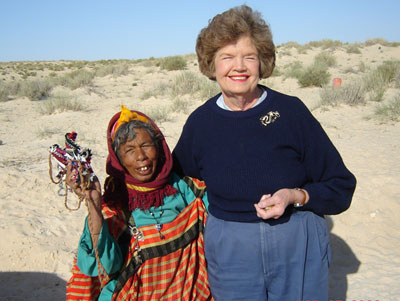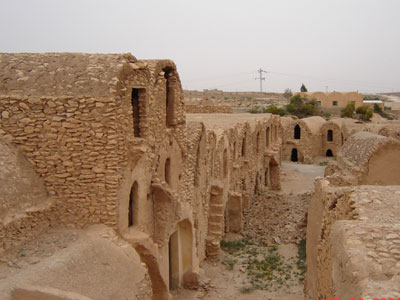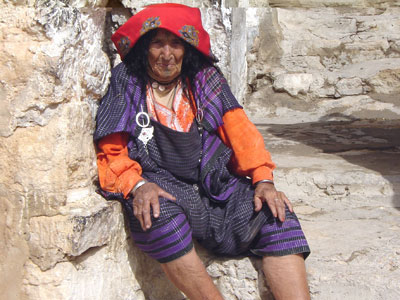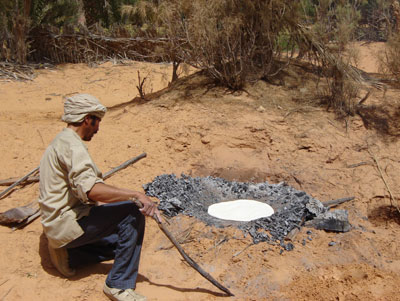Tunisia — Kasbahs, medinas, Roman ruins and the Sahara Desert
by Jean Nethery, Blairsville, GA
For years I have wanted to visit medieval cities on the Mediterranean coast, ride a camel on the Sahara Desert and explore still-intact Roman ruins. For 2009, Overseas Adventure Travel (OAT) offered a 15-day trip to Tunisia with a pretrip to Marrakesh, Morocco, and a post-trip extension to the Sahara. This was a new trip for OAT (Cambridge, MA; 800/493-6824, www.oattravel.com) and because my husband, Al, and I like small-group tours wrapped with adventure and fun-loving people, we opted to sign up for the March tour.
Starting out
Air transportation was included in the price of our tour, with transfers a part of the package. Unfortunately, Royal Air Maroc didn’t quite live up to its name, with poor service, unclean restrooms and individual overhead reading lights that were not working for most of the trip.
Further, the return trip on Alitalia from Rome to New York created havoc for five of us when Alitalia changed their flight schedule the day before (by eight hours) without notifying us. This threw all of our connecting flights off and caused irate passengers to wait in long lines for hours at both Rome and New York City. Our return to Atlanta took 52 hours.
On the positive side, we found Marrakesh to be a valuable addition as a pretrip option. A few highlights included visiting Medersa Ben Youssef (a 16th-century Islamic college) and the Palais Bahia and viewing a leather auction and the making of shoes. Visiting North Africa’s largest public square, Djemaa el-Fna, where storytellers, dancers, magicians, snake charmers and food vendors gather, made for an exciting cultural experience.
Our flight from Marrakesh to Casablanca and on to Tunis took three hours. Tunis has a European flavor, with many young businesspeople busily climbing into taxis dressed in business attire, briefcases in hand. French is commonly spoken there.
The food
The cuisine of Tunisia is a blend of the culinary traditions of desert dwellers and Mediterranean peoples. Its distinctive spiciness comes from the influence of neighboring countries as well as from its past.
The nomads were limited in cooking vessels so tended to use a conical-lidded pot, called a tagine, which now also refers to the mixture cooked in it. Lamb, chicken and seafood are often served along with carrots, cabbage, turnips and chickpeas.
The traditional oven-baked bread, khobz tabouna, is normally served with harissa (a paste of ground chili peppers and olive oil) and a traditional Tunisian salad similar to the French Niçoise or Greek-style salad.
Couscous is the national dish and may be prepared in many ways. Normally, it is piled in the middle of a platter with meat and vegetables on top.
There are two restaurants I’d recommend in Tunis. Restaurant Chez Nous (5, Rue de Marseille; phone 01 254 043) offered several fixed-price meals of excellent value. Including wine, our bill for five people was $87. At Le Malouf (108, Rue de Yougoslavie; phone/fax 71 34 37 71), we enjoyed a delicious fish meal with Tunisian salad and soup. Our meal there was slightly more expensive but a bit more elegant.
Both restaurants were an easy walk from our excellent, centrally located Africa Tunis Hotel (50 Avenue Habib Bourguiba; phone 011 216 7134 74 77, fax 7134 74 32).
Tunis
The capital may be best known for its medina full of palaces, mosques and fountains, found by following narrow, snaking walkways lined with busy artisans carving wooden objects or pounding imprints on silver items. But not to be missed is the Bardo Museum, Tunisia’s museum of archaeology, located in a 17th-century palace and containing a spectacular collection of Roman mosaics along with sarcophagi and statues from the Roman and Carthaginian periods.
A visit to the North Africa American Cemetery & Memorial, the final resting place for 2,841 Americans, allowed us to pay our respects to the soldiers who liberated Tunisia during World War II.
Next we walked up the hillside village of Sidi Bou Said for a sweeping view of the Gulf of Tunis and to observe its houses painted in gleaming white with sea-blue windows.
Choice of extras
An optional full-day tour to Dougga, a UNESCO World Heritage Site, proved worthwhile. Dougga is considered the best-preserved ancient Roman city in North Africa. We stood among the remains of a complete second-century town that once had 5,000 residents and included villas, temples, baths, paved streets and a forum.
Traveling by small bus from Tunis, we passed many olive and orange groves en route to Sousse, the third-largest city on the eastern coast, where some of the country’s finest beaches are located. The Sousse Palace Hotel offered a fine view of the sea, but our room needed a face-lift and the breakfasts were inconsistent.
Earlier in the day we stopped at the seaside town of Hammamet for lunch at the Restaurant Dar Lella (Rue Patrice Lumumba; phone/fax 72 280 871, www.darlella.com). This small, family-run restaurant offered superb service and tasty food.
We started our meal with the traditional brik, tiny parcels of minced lamb, beef or vegetables combined with an egg and wrapped in thin pastry, then deep fried. Served next was a Tunisian salad followed by delicious stuffed peppers and, finally, a slice of baklava.
Another optional tour went to El-Djem, which was built in the third century. El-Djem is home to the third-largest ancient Roman amphitheater in the world. Soaring impressively above the low-rise buildings of the town’s medina, this UNESCO World Heritage Site could once hold 35,000 spectators. A fabulous nearby museum housed mosaics from ancient villas.
Local interaction
One thing we especially like about OAT trips is the chance to mingle with local people and learn more about the culture. On this trip there were four such opportunities.
One excursion took us for lunch at a family’s home followed by the typical sipping of mint tea and an exchange of questions.
In Kairouan, considered the holiest of Tunisian cities, a discussion on the Islam faith by an imam gave us insight into that religion.
Lastly, the rituals of a Bedouin wedding were enacted at a family home, with volunteers from the group portraying the bride and groom. The colorful rites of hair swinging, henna painting and tea drinking were parts of the ceremony.
Hating to leave La Kasbah Golden Yasmin Hotel in Kairouan (Avenue IBN Jazzar Citte La Mosque; phone 011 216 77 237 301, fax 237 302), where our rooms were spacious and the meals outstanding, we drove to Tozeur.
Oases sights
On the edge of the Sahara Desert, Tozeur is known for its date palms and brick houses. The typical brick facades with geometric decorations that look more like lace and embroidery amazed us.
By horse cart we were transported to an oasis where date palm, apricot and almond trees flourished. The intensive procedure of pollinating and harvesting dates was explained, with some samples allowed. Later, during the horse cart ride, we watched bricks being molded by hand and baked in an outdoor oven.
A ride on the century-old Red Lizard train, once owned by the Bey of Tunis and furnished with antique brocade armchairs and brass fittings, made us recall an earlier era. The ride took us through the spectacular, nine-mile-long Seldja Gorge, whose sheer walls of red rock rise over 300 feet.
Our entire group participated in an optional full-day “Mountain Oases” tour to the oasis towns of Chebika, Tamerza and Mides. We boarded 4-wheel-drive vehicles at our hotel to view these garden spots in the heart of the desert. Through water conservation, technology and canalization, it is possible to grow crops in an otherwise inhospitable environment.
An off-road excursion into the desert dunes at Lariguett took us to movie sites where scenes from “The English Patient” and “Star Wars” were filmed.
Djerba
Continuing south to the island of Djerba, we stopped at Matmâta, a town of underground houses built in caves that were dug into the walls of sunken craters. What an excellent way to endure the summer’s torrid heat!
Djerba is a city of whitewashed mosques and groves of olive and citrus trees. Visiting the historic synagogue, El Ghriba (with a history going back to the sixth century BC), meant going through a metal detector with high security. The synagogue is beautifully decorated with ceramic tiles, woodcarvings and fabrics. We were told that throughout the years, this active Jewish community has lived in harmony with its Muslim neighbors.
The Cesar Thalasso Hotel in Djerba was not really up to par with our other hotels. The service was poor and the hotel itself, including the rooms, was in need of repair and renovation.
Into the Sahara
Five of us from our group of 16 (OAT limits its groups to 16 people) had chosen to go on the 3-night post-tour to the Sahara. Leaving Djerba in 4-wheel-drive vehicles, we departed for Tataouine, stopping along the way to discover the castle-like fortified villages known as ksars that served as granaries or collective storerooms.
Life in a ksar (fortress) centered on the spacious courtyard, populated by Berber men, women and children and once the center of their activities and play.
We viewed three very different ksars: Ksar Metameur, Ksar Haddada and Ksar M’gabla (fourth century AD).
Our hotel in Tataouine, Sangho Privilège Tataouine (phone 011-216 75 860 102, fax 75 862 177), was unique in that all rooms opened out onto a garden with pathways leading to the pool and dining room. The food was good, and the oasis-like town prepared us for our off-road desert trip the following day.
Our stay at the Pansea Desert Camp ([Djerba office] 4, Rue El Andalous, Sidi Mahr´ez; phone 011 21 67 575 9330, fax 575 9333), was excellent in every respect. The whole experience of getting there, traveling over bumpy sand dunes with only one pit stop at a primitive shack where we could buy water and relieve ourselves, was awesome.
Suddenly we spied a green oasis in the distance, where our tent camp was located. The luxurious tent included a full bath, a queen-sized bed, plush rugs and an air-conditioner.
Meals at the camp were well prepared and tasty; however, our favorite meals were those prepared just for our group of five, in a small tent apart from the camp. We watched the preparation and baking of unleavened bread for lunch and yeast bread for dinner, baked in a campfire.
For years I’ve wanted to ride a camel and felt the Sahara offered just the right camel ride for me. We mounted our camels at the edge of the oasis and rode for about an hour to Ksar Ghilane, an outpost built by the Romans. All of our camels appeared healthy and well groomed and they didn’t spit.
The details
This well-thought-out OAT trip to Tunisia included everything I wanted to see and gave us plenty of diversity, from modern city life to life in an oasis. In order to keep the cost down, OAT included four or five optional tours; these shouldn’t be missed and should be figured into your total cost.
Our guide for most of Tunisia was Henaien Mohamed (phone 216 98403 818, e-mail henaien-mohamed@hotmail.com.fr), who is on our list of the top five guides we’ve ever had.
The total per-person cost for our tour, including round-trip air from Atlanta, was $5,515. This included the pretour trip to Marrakesh ($895) and the post-tour excursion to the Sahara ($995). We spent an extra $315 for the optional tours taken.
Rather than going with OAT’s offered travel insurance, we used Travelex (800/228-9792, www.travelex-insurance.com) for about half the price.





